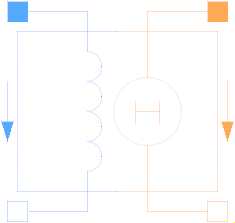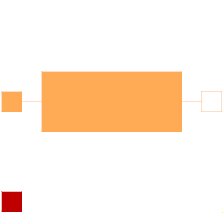 Package Modelica.Magnetic.QuasiStatic.FluxTubes.Basic
Package Modelica.Magnetic.QuasiStatic.FluxTubes.BasicBasic elements of magnetic network models
 Package Modelica.Magnetic.QuasiStatic.FluxTubes.Basic
Package Modelica.Magnetic.QuasiStatic.FluxTubes.Basic
This package contains the basic components of quasi static flux tubes package.
Extends from Modelica.Icons.Package (Icon for standard packages).
| Name | Description |
|---|---|
ConstantPermeance | Constant permeance |
ConstantReluctance | Constant reluctance |
Crossing | Crossing of two branches |
EddyCurrent | For modelling of eddy current in a conductive magnetic flux tube |
ElectroMagneticConverter | Electro-magnetic energy conversion |
Ground | Zero magnetic potential |
Idle | Idle running branch |
LeakageWithCoefficient | Leakage reluctance with respect to the reluctance of a useful flux path (not for dynamic simulation of actuators) |
Short | Short cut branch |
 Model Modelica.Magnetic.QuasiStatic.FluxTubes.Basic.Ground
Model Modelica.Magnetic.QuasiStatic.FluxTubes.Basic.Ground
The magnetic potential at the magnetic ground node is zero. Every magnetic network model must contain at least one magnetic ground object.
| Type | Name | Description |
|---|---|---|
PositiveMagneticPort | port |
 Model Modelica.Magnetic.QuasiStatic.FluxTubes.Basic.ElectroMagneticConverter
Model Modelica.Magnetic.QuasiStatic.FluxTubes.Basic.ElectroMagneticConverter
The electro magnetic energy conversion is given by Ampere's law and Faraday's law respectively:

In this equation
 is the magnetomotive force that is supplied to the connected magnetic circuit,
is the magnetomotive force that is supplied to the connected magnetic circuit,
 is the magnetic flux through the associated branch of this magnetic circuit. The negative sign of the induced voltage
is the magnetic flux through the associated branch of this magnetic circuit. The negative sign of the induced voltage
 is due to Lenz's law.
is due to Lenz's law.
The static inductance is calculated from the flux linkage

and the current
 :
:

This quantity is calculated for information only.
 is set to
is set to

if
 .
.
| Type | Name | Default | Description |
|---|---|---|---|
Real | N | 1 | Number of turns |
| Type | Name | Description |
|---|---|---|
PositiveMagneticPort | port_p | Positive magnetic port |
NegativeMagneticPort | port_n | Negative magnetic port |
PositivePin | pin_p | Positive electric pin |
NegativePin | pin_n | Negative electric pin |
 Model Modelica.Magnetic.QuasiStatic.FluxTubes.Basic.ConstantReluctance
Model Modelica.Magnetic.QuasiStatic.FluxTubes.Basic.ConstantReluctance
This constant reluctance is provided for test purposes and simple magnetic network models. The reluctance is not calculated from geometry and permeability of a flux tube, but is provided as parameter.
Extends from Modelica.Magnetic.QuasiStatic.FluxTubes.Interfaces.PartialTwoPorts (Partial component with magnetic potential difference between two magnetic ports p and n and magnetic flux Phi from p to n).
| Type | Name | Default | Description |
|---|---|---|---|
Reluctance | R_m | 1 | Magnetic reluctance |
| Type | Name | Description |
|---|---|---|
PositiveMagneticPort | port_p | Positive quasi-static magnetic port |
NegativeMagneticPort | port_n | Negative quasi-static magnetic port |
 Model Modelica.Magnetic.QuasiStatic.FluxTubes.Basic.ConstantPermeance
Model Modelica.Magnetic.QuasiStatic.FluxTubes.Basic.ConstantPermeance
This constant permeance is provided for test purposes and simple magnetic network models. The permeance is not calculated from geometry and permeability of a flux tube, but is provided as parameter.
Extends from Modelica.Magnetic.QuasiStatic.FluxTubes.Interfaces.PartialTwoPorts (Partial component with magnetic potential difference between two magnetic ports p and n and magnetic flux Phi from p to n).
| Type | Name | Default | Description |
|---|---|---|---|
Permeance | G_m | 1 | Magnetic permeance |
| Type | Name | Description |
|---|---|---|
PositiveMagneticPort | port_p | Positive quasi-static magnetic port |
NegativeMagneticPort | port_n | Negative quasi-static magnetic port |
 Model Modelica.Magnetic.QuasiStatic.FluxTubes.Basic.LeakageWithCoefficient
Model Modelica.Magnetic.QuasiStatic.FluxTubes.Basic.LeakageWithCoefficient
Differently from the flux tube elements of package Shapes.Leakage
that are calculated from their geometry, this leakage reluctance is calculated with reference to the total reluctance of a useful flux path. Parameter c_usefulFlux is the ratio of the useful flux over the total flux.
Extends from Modelica.Magnetic.QuasiStatic.FluxTubes.Interfaces.PartialLeakage (Base class for leakage flux tubes with position-independent permeance and hence no force generation; mu_r=1).
| Type | Name | Default | Description |
|---|---|---|---|
CouplingCoefficient | c_usefulFlux | 0.7 | Ratio useful flux/(leakage flux + useful flux) = useful flux/total flux |
| Type | Name | Default | Description |
|---|---|---|---|
Reluctance | R_mUsefulTot | Total reluctance of useful flux path as reference |
| Type | Name | Description |
|---|---|---|
PositiveMagneticPort | port_p | Positive quasi-static magnetic port |
NegativeMagneticPort | port_n | Negative quasi-static magnetic port |
 Model Modelica.Magnetic.QuasiStatic.FluxTubes.Basic.EddyCurrent
Model Modelica.Magnetic.QuasiStatic.FluxTubes.Basic.EddyCurrent
Eddy currents are induced in a conductive magnetic flux tube when the flux changes with time. This causes a magnetic voltage drop in addition to the voltage drop that is due to the reluctance of this flux tube. The eddy current component can be thought of as a short-circuited secondary winding of a transformer with only one turn. Its resistance is then determined by the geometry and resistivity of the eddy current path. Alternatively, a total conductance parameter can be used.
Partitioning of a solid conductive cylinder or prism into several hollow cylinders or separate nested prisms and modelling of each of these flux tubes connected in parallel with a series connection of a reluctance element and an eddy current component can model the delayed buildup of the magnetic field in the complete flux tube from the outer to the inner sections. Please refer to [Ka08] for an illustration.
Extends from Modelica.Magnetic.QuasiStatic.FluxTubes.Interfaces.PartialTwoPorts (Partial component with magnetic potential difference between two magnetic ports p and n and magnetic flux Phi from p to n) and Modelica.Thermal.HeatTransfer.Interfaces.PartialElementaryConditionalHeatPort (Partial model to include a conditional HeatPort in order to dissipate losses, used for textual modeling, i.e., for elementary models).
| Type | Name | Default | Description |
|---|---|---|---|
Boolean | useConductance | false | Use conductance instead of geometry data and rho |
Conductance | G | 1.020408163e+7 | Equivalent loss conductance G=A/rho/l |
Resistivity | rho | 9.8e-8 | Resistivity of flux tube material (default: Iron at 20degC) |
Length | l | 1 | Average length of eddy current path |
Area | A | 1 | Cross sectional area of eddy current path |
final Resistance | R | rho * l / A | Electrical resistance of eddy current path |
Boolean | useHeatPort | false | =true, if heatPort is enabled |
final Temperature | T | 273.15 | Fixed device temperature if useHeatPort = false |
| Type | Name | Description |
|---|---|---|
PositiveMagneticPort | port_p | Positive quasi-static magnetic port |
NegativeMagneticPort | port_n | Negative quasi-static magnetic port |
HeatPort_a | heatPort | Optional port to which dissipated losses are transported in form of heat |
 Model Modelica.Magnetic.QuasiStatic.FluxTubes.Basic.Idle
Model Modelica.Magnetic.QuasiStatic.FluxTubes.Basic.Idle
This is a simple idle running branch. The magnetic flux through this component is equal to zero.
Extends from Modelica.Magnetic.QuasiStatic.FluxTubes.Interfaces.PartialTwoPorts (Partial component with magnetic potential difference between two magnetic ports p and n and magnetic flux Phi from p to n).
| Type | Name | Description |
|---|---|---|
PositiveMagneticPort | port_p | Positive quasi-static magnetic port |
NegativeMagneticPort | port_n | Negative quasi-static magnetic port |
 Model Modelica.Magnetic.QuasiStatic.FluxTubes.Basic.Short
Model Modelica.Magnetic.QuasiStatic.FluxTubes.Basic.Short
This is a simple short cut branch. The magnetic voltage of this component is equal to zero.
Extends from Modelica.Magnetic.QuasiStatic.FluxTubes.Interfaces.PartialTwoPorts (Partial component with magnetic potential difference between two magnetic ports p and n and magnetic flux Phi from p to n).
| Type | Name | Description |
|---|---|---|
PositiveMagneticPort | port_p | Positive quasi-static magnetic port |
NegativeMagneticPort | port_n | Negative quasi-static magnetic port |
 Model Modelica.Magnetic.QuasiStatic.FluxTubes.Basic.Crossing
Model Modelica.Magnetic.QuasiStatic.FluxTubes.Basic.Crossing
This is a simple crossing of two branches. The ports port_p1 and port_p2 are connected, as well as port_n1 and port_n2.
| Type | Name | Description |
|---|---|---|
PositiveMagneticPort | port_p1 | Positive port_p1 connected with port_p2 |
PositiveMagneticPort | port_p2 | Positive port_p2 connected with port_p1 |
NegativeMagneticPort | port_n1 | Negative port_n1 connected with port_n2 |
NegativeMagneticPort | port_n2 | Negative port_n2 connected with port_n1 |